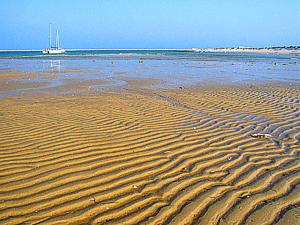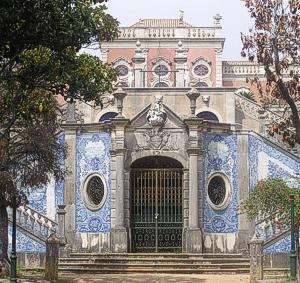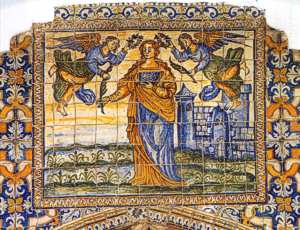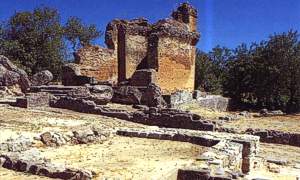|
Faro |
|
| Portugal > Tourism > Algarve > Faro > Municipality | |
| Home | History | The City | Lodging | Handicrafts | Gastronomy | |
   |
| Beaches |
| The long strip of dunes that separates the sea from the Ria Formosa is a paradise for anyone who enjoys sun, sand and sea. With the advantage that visitors can choose from a necklace of separate islands, and have mile after mile of sandy beaches all to themselves. |
| Ilha de Faro Linked to the mainland by a road, this island has a small nucleus of beach houses, restaurants and other tourist facilities. Ilha de Barreta This island is truly calm and solitary. Thanks to the fact that there are no regular ferry connections. It is an excellent destination for anyone who has hired a boat or is lucky enough to have their own and who wants to enjoy the pleasures of sea and sand undisturbed by other holidaymakers. Ilha do Farol Apart from a few fishermen's cabins, there is nothing on these islands but sand... |
|
 |
| Culatra A former fishing village, until a few decades ago the houses of Culatra had wooden walls and thatched roofs. Fishing still goes on, and shell fish are harvested from the Ria. There is an extensive beach which is quiet, with a family atmosphere. Regular steam boat services run to the Farol and Culatra beaches from Faro (summer) and Olhão (all year). |
| Places of Interest |
|
Estoi Palace - (Pousada de Faro) - The romantic tastes of
the fast owner, a scion of one of the most distinguished families
of the Algarve nobility, inspired him to build a country house surrounded
by gardens in a beautiful natural setting. Rather than turning to
the medieval models favoured by the revivalists of the period (first
half of the 19th century). as exemplified by the Royal Pena Palace
in Sintra. The opted for a style combining neo-baroque and "neo-rococo"
elements. After several decades of neglect the palace was bought by
a wealthy, pharmacist (who later became Viscount of Estoi), who continued
work on it and made it his home (early, 30th century). The palace
is a huge building, its exterior partially covered with tiles bearing
floral decoration and depicting a variety of scenes. Inside, the decoration
on the plaster ceilings the finest in the Algarve - is worthy of mention,
as is the chapel, the hall; the reception and dining rooms, the two
tea pavilions.
|
|
 |
| At the entrance to the palace there is a small temple containing a waterfall and a statue of the Three Graces on a shell, a copy of the work by the Italian sculptor Antonio Canova (1757-1822). Statues of Venus and Diana stand in niches. The gardens are in the late romantic style, set out on different levels, with flights of steps, lakes and statues of marble and pottery. |
|
Main church - Built in the 15th century;
the church suffered a number of alterations in the 18th. It has an
interior consisting of three naves, with ogival arches. The main chapel
has a panelled vault, preceded by a triumphal arch that is in the
Manueline style but already displays the influence of renaissance
art (16th century). The altars have carved retables (18th century).
There are statues from the 17th and 18th centuries, with pride of
place going to that of Santa Barbara (St. Barbara - 17th century).
In the chapel of Santo António (St. Anthony) there are two
16th century paintings on wood. The walls are decorated with an ashlar
of polychrome tiles and above the triumphal arch there is a panel
depicting the coronation of Santa Barbara by two angels (1702).
|
|
 |
| Hermitage of Santa Catarina (St. Catherine) -Situated at Gorjoes; this small 17th century church was reworked in the 19th. The retable and status inside date from the 18th century. |
| Handicrafts |
| Faro is an ideal place to explore the colourful world of Algarvean crafts. Tiles decorated with traditional motifs are produced locally. Further inland, in Santa Bárbara de Nexe and Estoi, the womenfolk still weave and plait palm leaves to make baskets, hats and mats. |
| Gastronomy |
| All of the Algarve's best known dishes can be tasted in Faro. But anyone who wants to try the typical fishermen's recipes should sample the local fish soup and the traditional razor clam risotto. Choosing among the many local cakes and desserts is a hard task because they all make extensive use of the tasty local figs and almonds. The best way to round off a meal is a glass of fig brandy or "medronho", a spirit made with the fruit of the strawberry tree. |
| Home | History | The City | Lodging | Handicrafts | Gastronomy | |
| Portugal > Tourism > Algarve > Faro > Municipality | |
|
Municipality |
|
